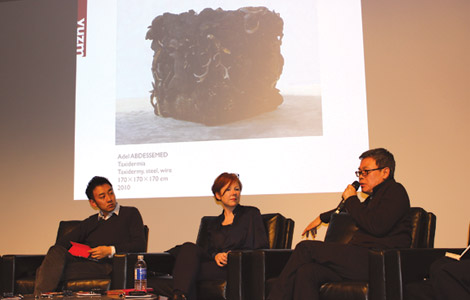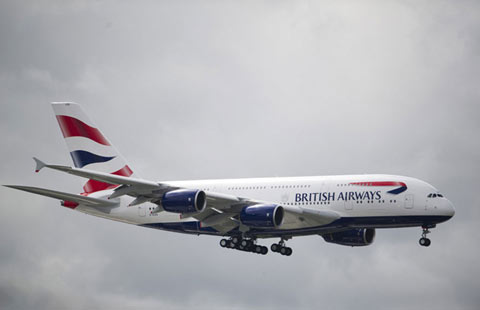China reaching for new 'space odyssey'
Updated: 2014-03-13 08:33
By Ji Shaoting and Wang WenXinhua News Agency (China Daily)
|
||||||||
In the near future, in outer space, Chinese scientists and their international colleagues, perhaps in the company of robots, will seek knowledge in laboratories on China's future space station.
Aboard the space station, deep in space, researchers will probe the profound mysteries of the universe, while explorers penetrate the darkness beyond both the moon and Mars.
This is no sci-fi movie, but a vision of the future presented to the National People's Congress and members of the Chinese People's Political Consultative Conference during the two sessions. The vision is of a "space odyssey" for China's future and for space exploration.
By the year 2020, the International Space Station is expected to be retired, while, in that same year, China's space station should be completed. China's station may then be mankind's only foothold in space.
Zhang Bonan, chief designer of the program, said the station will have multiple cabins with a large capacity and high power. "The 2020 space station will be a national space lab," Zhang said.
"Experiments there will be diverse and flexible," he said, "International cooperation will be encouraged, and the door of the lab will open for any experiments that fit the requirements."
Flight system
The first step to the stars is new technology, principally in supply lines. A cargo ship named Tianzhou (Heavenly Vessel) will ferry cargo back and forth to the station.
China is expected to launch a cargo ship around 2016 to serve the Tiangong-2 space laboratory, said Zhou Jianping, chief designer of the manned space program and member of the CPPCC National Committee.
The cargo ship will be delivered into space by the new Long March-7 carrier rocket and dock with Tiangong-2 automatically, Zhou said.
A cargo transportation system that supplies goods and propellants is key to China building its own space station, he said.
Liang Xiaohong, Party chief of the China Academy of Launch Vehicle Technology, also a member of the CPPCC National Committee, said that the Long March carrier rocket series is already industrialized. By 2020, China will meet a market demand of more than 270 domestic and 460 foreign launches.
'Space bus'
The Tianzhou cargo ship and the Long March rocket will be ready around 2016, heralding a new era in space transportation. Moreover, China is expected to launch a "space shuttle bus" this year to carry payload.
The "space shuttle bus", Yuanzheng-1 (Expedition-1), is an upper stage aircraft attached to a carrier rocket. It can carry spacecraft, using its own power, into an initial orbit, Liang said, adding that it has the same function as a carrier rocket and can take multiple craft to different locations.
Yuanzheng-1 will play an important role in future moon and Mars explorations as well as orbital transfers and space debris clearing, he said.
While the Jade Rabbit moon rover sleeps on the moon, other dreams are taking wing.
Preparation for the 2017 launch of lunar probe Chang'e-5 is going as planned, said Ye Peijia, a top scientist with the Chang'e-3 lunar probe mission.
Chang'e-5, as part of China's third-phase lunar program, is expected to bring back moon rock samples to Earth, which Ye believes will be "a historic moment".
The more sophisticated Chang'e-5, including unmanned sampling and returning, requires breakthroughs in moon surface takeoff technology, sampling encapsulation, rendezvous and docking in lunar orbit, as well as high-speed Earth reentry.
To make sure the mission is a success, a Chang'e-5 test probe will be launched this year to rehearse the route, Ye said.
(China Daily 03/13/2014 page3)

 Who's got the No 1 Chinatown in the US?
Who's got the No 1 Chinatown in the US?
 Obama sweats over sweaters during shopping
Obama sweats over sweaters during shopping
 Chinese arcade games on display
Chinese arcade games on display
 Photos of stolen passport holders released
Photos of stolen passport holders released
 S Korea, Canada signs comprehensive FTA
S Korea, Canada signs comprehensive FTA
 Thai travel agents questioned over tickets for missing jet
Thai travel agents questioned over tickets for missing jet
 Crossing swords
Crossing swords
 Creating a whole new Chinese art history
Creating a whole new Chinese art history
Most Viewed
Editor's Picks

|

|

|

|

|

|
Today's Top News
NYC building collapses
China, mutinational team expand search for missing jet
Crimea declares independence
Vietnam partially suspends search
Lenovo guarantees IBM strikes
Snowden defends his NSA leaks
Hunts for fugitives to intensify
Malaysia track jet to west coast
US Weekly

|

|






